I was first properly introduced to the term “patient and public involvement and engagement” five and half years ago, working with research grant applications at Wellcome. I was one of the lucky people to be part of the first intake of their Graduate Development Programme, where I got to work in four departments for six months each. The organisation opened my eyes to how important it is to get the public interested in science and the vast possibilities of how to do so. At lunchtimes I had the luxury of going to lectures and exhibitions in the Wellcome Collection next door, which would always be bustling with curious members of the public.
I had previously worked in a lab in Gran Canaria doing animal research into Aloe Vera and Alzheimer’s disease, of which the patient felt very far removed. At Wellcome, I realised I wanted to be closer to the people the research was helping and translating that research into practice.
This led me to apply for a job in the policy team at Cancer Research UK, where I could see how the work I was doing was helping diagnosis cancer earlier and save lives. When I started there, the patient and public involvement team did not exist. By the time I left, three years later, there had been a culture shift to ensure people affected by cancer were at the heart of the organisation. There were over 20 staff, patient boards, patients on the funding committees, ambassadors and “involvement coaches” (who were specifically selected and trained patients, who mentored other patient representatives). When I say patients that includes carers, survivors, family and members of the public.
Patient and public involvement in research is when citizens work in partnership with researchers and healthcare professionals in order to design, manage or conduct a research study. Public engagement refers to information about research being shared and discussed with the public ideally in a two-way conversation.
In my next role at the organisation, I led on patient and public involvement for the Population Research Team. It involved, for example, recruiting and supporting patients to join our funding committees and organising the first patient panel to judge research posters at a large cancer early diagnosis conference. Many junior researchers would not think to involve patients in helping to design their studies, so I organised a new training workshop to help bring the two together. This workshop allowed a patient, supported by an involvement coach, to advise researchers about how improve their study, e.g. to ensure it would recruit and that the outcome would be most relevant to patients. The passion and gratitude from the researchers and the altruistic nature of the patients’ motivations, solidified my decision to move into a role that could support these conversations and successful partnerships.
At the same time, the NIHR Imperial Patient Safety Translational Research Centre (PSTRC) were advertising a new role, dedicated to revamping how they involve and engage the public and patients in research. I was thrilled to become the Patient and Public Involvement and Engagement Manager in September 2016.
Since my time at Imperial, it has been fantastic to work with local organisations, such as Northwest London Collaboration in Leadership in Applied Health Research and Care (CLAHRC). A highlight was attending their quarterly Exchange Network, where patient representatives and people working in involvement come together share expertise, through discussions and action learning.
I have recently been working with colleagues and patients to revamp our patient and public involvement and engagement strategy. Last week we had an interactive workshop with patients, members of the public, researchers and clinicians to improve our draft strategy, held in the creative space the HELIX Centre. We will continue to work with this group and others to shape how we involve patients and the public at the centre.
Patients and the public are central to our work. We will also be co-producing our communication strategy with citizens over the coming months. We are looking for novel ways to engage with different groups of people, as well as through videos, podcasts and social media. If you are interested in hearing more about our new initiatives, please go to our website or get in touch: Anna Lawrence-Jones.

Great to hear that work is progressing. We appreciate you mentioning the NIHR CLAHRC NWL and the Exchange Network. We are always interested in new ways to approach involvement and to support people who are new to the field so we can create genuine learning opportunities with patients, carers and families.